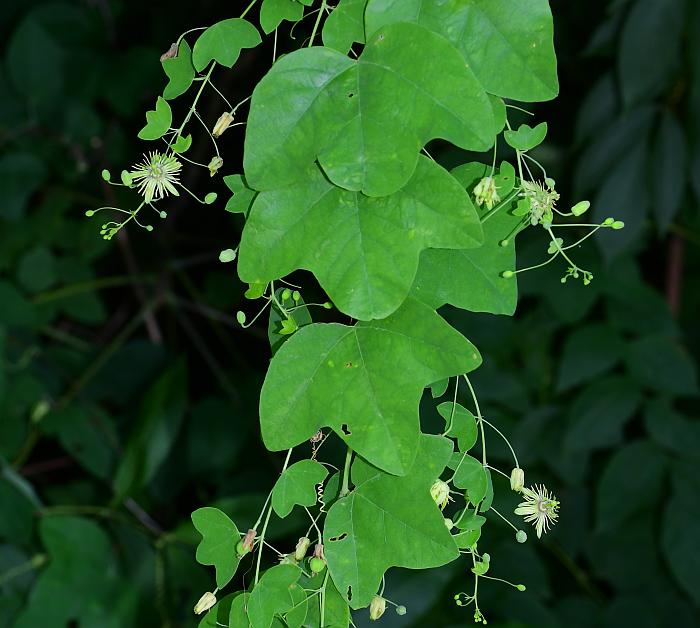Passiflora lutea L.
Yellow Passion Flower

Native
CC = 4
CW = 5
MOC = 64
© SRTurner
Passiflora lutea L.Yellow Passion Flower | |
 |
Native CC = 4 CW = 5 MOC = 64 |
© SRTurner |
|
Family - Passifloraceae Habit - Perennial vine. Stem - Lax or climbing into other vegetation, to 4 m or more long, glabrous or very sparsely hairy, with axillary curled tendrils.
Leaves - Alternate, petiolate, simple, stipulate, glabrous. Petioles 1-6 cm long. Leaf blades shallowly 3 lobed, to 12 cm along the central midvein, to 16 cm wide, usually wider than long, the lobes rounded to bluntly pointed at the tip, the upper surface dark green, often mottled with lighter areas, the undersurface lighter green, not glaucous, the margins entire. Stipules 4-5 mm long, linear to narrowly lanceolate.
Inflorescences - Axillary, the flowers solitary or often in pairs. Flower stalks 1.5-5.0 cm long, slender, elongating slightly at fruiting.
Flowers - Flowers actinomorphic, perfect, perigynous, 1.5-2.5 cm wide, without subtending bracts. Sepals 5-10 mm long, 2-3 mm wide, narrowly oblong, pale greenish yellow, not awned. Petals 3-7 mm long, 1-2 mm wide, linear-oblong, pale greenish yellow. Corona filaments in several series, the outer series 5-10 mm long, linear, pale yellow to yellow, the middle series 3-5 mm long, club-shaped, pale yellow to yellow, the inner membranous series 1.5-2.5 mm long, pale yellow to yellow, often purple-tinged toward the base. Ovary glabrous.
Fruits - berries, 0.9-1.5 cm long, globose to ovoid, dark purple when ripe. Seeds 4-7, surrounded by a pulpy aril, 3-5 mm long, 3.0-4.5 mm wide, the surface with 6 or 7 relatively coarse cross-ridges and grooves, the ridges with numerous finer longitudinal grooves, white to dark brown.
Flowering - May - August. Habitat - Forests, bluffs, glade margins, streambanks. Origin - Native to the U.S. Lookalikes - Broadly, Menispermum canadense. Other info. - This interesting vine is common in the southern half of Missouri, but apparently absent in the northern half. Its North American distribution comprises a sharply-defined region of about the southeastern third of the country. It is easily recognized by its small but fascinatingly complex flowers, or vegetatively by the distinctively shaped leaves. The distant lookalike Menispermum canadense has leaves of a different shape (though this is somewhat variable), and which are also peltate, with the petiole attached to the leaf blade slightly interior of the margin. Leaves of Passiflora lutea have petioles attached at the margin. The species is most often seen in vegetative condition but in low, moist woods flowering plants are common. Photographs taken at Broemmelsiek County Park, St. Charles County, MO, 6-21-2010, Weldon Spring Conservation Area, St. Charles County, MO, 8-01-2010 and 6-27-2012, Shaw Nature Reserve, Franklin County, MO, 6-22-2014, Onondaga Cave State Park, Crawford County, MO, 6-25-2014, along the Katy Trail near Dutzow, Warren County, MO, 7-11-2016, 7-06-2017, 11-05-2019, and 7-29-2022, and along the Katy Trail near Marthasville, Warren County, MO, 9-05-2019 (SRTurner); also in St. Louis, St. Louis County, MO, 9-11-2022 (KBildner). |